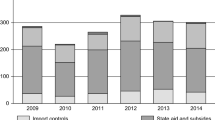Abstract
Both parties to an eventual EU India FTA have agreed that it should not merely address tariff barriers but should also go further into what is known as deep integration, originally developed in the 1990s by R.Z. Lawrence. This relates to the removal of all obstacles to cross border business whether actual trade barriers or domestic regulations. We distinguish deep institutional integration from the deep integration of markets. We ask the question how one may support the other. There are potential market failures that can be addressed by trans-national rules on standards and technical regulations and services, but we conclude that the biggest impact of a deep RTA would be on the domestic economy of India if it provides an opportunity for reform. It should be noted that the paper draws on a study undertaken by the authors for DG Trade, but it represents only the views of the authors.



Similar content being viewed by others
Notes
Select Committee on Business and Enterprise Fifth Report, April 2008, http://www.publications.parliament.uk/pa/cm200708/cmselect/cmberr/209/20907.htm
But see Li (2008) for an alternative interpretation of the East Asian story.
Though with retail outlets mushrooming in every nook and cranny of the country, this may become less of a concern.
Horizontal plus vertical does not add to 100% because there are trade categories the calculation of unit values is not possible.
CEPII-CIREM (2007)
The GATS classifies four “modes” of services delivery (these are the different ways in which services can be traded across borders): Mode One, which is the cross-border supply of services. An illustration of this is business process outsourcing units in India doing online medical transcriptions. Mode Two is consumption of services abroad. E.g. Indian tourists going to the EU. Mode Three is commercial presence, such as Deutsche Bank setting up operations in Mumbai. Finally, Mode Four is the movement of natural persons across borders to deliver services. An illustration of this is Indian nurses joining the NHS in the UK.
The Hindu Business Line, 3 April
Debroy (2005)
ISO 17020 for inspection bodies, ISO 17025 for labs and ISO Guide 65 for product certification
A major reason for the big change in the contribution of other services exports to the total is their coverage—with a more detailed breakdown available since 2004–05, this category largely comprises unclassified services, while in the preceding period they also included advertising, rentals, office maintenance, prizes, exhibitions and the like.
The RCA index for a given sector is calculated by taking the share of a particular sector’s exports in that country’s total exports of goods and services, and dividing this by the ratio of global exports in this sector to the total global exports of goods and services. An RCA index with value greater than unity indicates a comparative advantage in the sector, while a value less than unity indicates a comparative disadvantage.
In any case, OECD services exports made up 75% of global services exports in the last decade.
References
Arnold, Jens Matthias, Beata Javorcik and Aaditya Mattoo (2006) ‘The productivity effects of services liberalization: Evidence from the Czech Republic,’ World Bank Policy Research Working Paper 4109
Arnold, Jens Matthias, Beata Javorcik, Molly Lipscomb and Aaditya Mattoo (2007) ‘Services Reform and Manufacturing Performance: Evidence from India,’ World Bank, mimeo
CEPII-CIREM (2007) ‘Economic impact of a potential FTA between the European Union and India,’ Framework Contract No TRADE/05/H3/01/1c, Commission of the European Union—Directorate-General for Trade
Chauvin, Sophie and Françoise Lemoine “India in the world economy: Traditional Specialisations and Technology Niches” CEPII Working paper No 2003–09
Debroy, Bibek (2005) ‘The SPS and TBT agreements- implications for Indian policy’. Indian Council for Research on International on Economic Relations (ICRIER Working Paper 163, June 2005
Department of Industrial Policy & Promotion (2006) ‘Foreign Direct Investment Policy,’ Ministry of Commerce and Industry, Government of India
Gasiorek M et al (2007) ‘A qualitative analysis of a potential free trade agreement between the European Union and India’ http://trade.ec.europa.eu/doclib/docs/2007/june/tradoc_135112.pdf
Li, X (2008) ‘Regional Trading Agreements in East Asia: Effect on Vertical- Specialisation-Based Trade’, this volume. doi:10.1007/s10308-008-0215-x
Shingal, Anirudh “Three Essays on Trade in Services: Exploring tradability, regional trade and government procurement,” University of Sussex DPhil Dissertation, in preparation
World Bank (2004) ‘Sustaining India’s Services Revolution: Access to Foreign Markets, Domestic Reform and International Negotiations’
Acknowledgements
This paper draws heavily on “A Qualitative analysis of a potential Free Trade Agreement between the European Union and India” by Michael Gasiorek, Peter Holmes, Sherman Robinson, Jim Rollo, Anirudh Shingal and CUTS International. It includes material based on the research by Ms Sanchita Chatterjee.
Author information
Authors and Affiliations
Corresponding author
Rights and permissions
About this article
Cite this article
Holmes, P., Shingal, A. Potential Benefits from a Deep EU–India Free Trade Agreement. Asia Eur J 7, 43–62 (2009). https://doi.org/10.1007/s10308-008-0204-0
Published:
Issue Date:
DOI: https://doi.org/10.1007/s10308-008-0204-0



